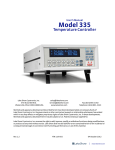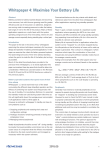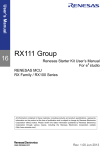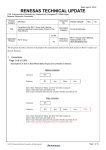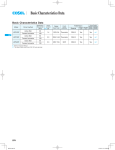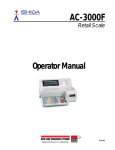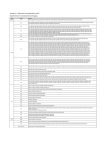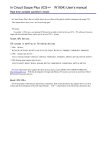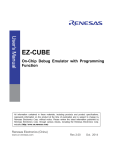Download The Rules of Low Power MCU Design
Transcript
Whitepaper 2: The Rules of Low Power MCU Design Abstract Market and Government demands for a greener environment and better use of resources such as making batteries last longer means that the need for low power operation and standby is increasing. Conversely the demands for more performance and functionality are also on the rise, a combination not usually recognised for lowering power. Introduction This paper is the second in a series four whitepapers that examining the various considerations for low power design and operation. In this paper we look at the many “tricks” (techniques) that allow designers to combine both performance and low power consumption in their applications. Specific examples and references included are based on the 16-bit RL78 and the 32-bit RX100 families outlined in the first whitepaper (powering your system from a lemon!). It should be noted that while specific devices are used for reference (RL78/L12 and RX111) the principles can apply equally to the other RL78 and RX MCU families. “Tricks” to Lower Power Consumption As outlined in whitepaper 1, the MCU is a significant factor in the power used by applications, but it is not always the only area for consideration and while application requirements differ there is a general set of topics that contribute to the power used that we will examine in this whitepaper. (RTC, UART and Timer etc.). The premise here is the main clock is speed is reduced or stopped completely and that any operation is based on a low speed clock such as 32 KHz or internal oscillator. Obviously the optimum is where the system is completely stopped and all clock sources are halted and the MCU powered at or above the minimum supply voltage where the MCU will be held in a static state. Examples of our featured products showing the reduction in power consumption are shown in figures 1 and 2 below. Here the HALT/SLEEP modes are using a low speed 32 KHz clock and STOP/SW Standby is with all clocks stopped. RL78 Notes 1: At NOP instruction 2: Active RTC + LVD function 3: Active WDT + LVD function 4: All stopped, RAM retained 0.38 µA2 32 KHz with RTC + LVD 0.3 µA 32 KHz 0.53 µA3 With WDT + LVD Stop Mode Halt Mode 1.MCU Standby modes 2.MCU Operating clock speed 3.MCU Clock Source Selection 4.MCU Peripheral Operation 5.MCU I/O Pin use 6.System Integration 7.Power Supply options 0.23 µA4 Figure 1 – RL78 Standby Current Consumption RX100 2.5 These topics are reviewed in detail below and please refer to the other papers in the series as they will cover some more of the background and specific topic associated with low power design. The other papers in the series are listed at the end of this paper for reference. MCU Standby Modes Standby modes used during idle or stop periods of the system operation are generally considered as the main method of reducing the average power consumption in any battery powered system. Many MCU families offer a number of low power options because applications require different scenarios where some peripherals still have to operate 32 KHz 2 Stop 1.5 1 0.5 0 µA Sleep Deep Sleep SW Standby Figure 2 – RX100 Standby Current Consumption As outlined in whitepaper 1 (lemon demonstration), the two low power modes of the RL78, HALT and STOP (see 2015.05 1 Whitepaper 2: The Rules of Low Power MCU Design figure 1 on page 1) offers significant power reduction in either mode, plus the SNOOZE mode (linked to STOP mode) which decreases the number of times that the CPU needs to be woken until a valid wake up condition occurs, reduces the average STOP mode current even further. For example analysing a heating controller based on the RL78 in “SNOOZE” mode, measures the temperature (ADC conversion), checks the result and reports to the HVAC unit controller only if the temperature is out of range (see figure 3). By only using “STOP” an average current of 880 nA can be achieved, but by using “SNOOZE” operation as well the average current is reduced to 680 nA, a 25% reduction which can be directly translated into the battery lasting 25% longer. For the RX100 MCU family the three standby modes SLEEP, DEEP SLEEP and SOFTWARE STANDBY as shown in figure 2 on page 1 and outlined in paper 1 are understandably not quite as low as the RL78 but still offer major power savings for a highly integrated high performance MCU family. One last factor is not to ignore any external analogue function or digital peripheral, so that during standby it is important that these can be “turned off” as some analogue functions can consume as much power as the MCU. I believe it is clear that by employing MCU standby modes and total system shut down as part of the design, very low average currents can be achieved thus maximising battery life. scenario for the RX111, at full speed current consumption is around 10 mA (32 MHz @ 3.6 V) whereas at 1 MHz consumption is reduced by 90% to around 1 mA and at 32 KHz it is 11.5 µA. So a similar picture can be seen for our two MCU families. Operating with a slower system clock is of course somewhat of a trade off as foreground processing takes longer impacting average current, so an analysis of the average current at different clock speeds is recommended. Average current consumption can generally be calculated with the following equation MCU Operating Clock Speed A simple and perhaps obvious way to reduce power consumption that should not be overlooked is to operate the MCU and any external peripherals at a lower clock frequency, either permanently or during the idle periods. Reducing the system clock frequency from the maximum available will reduce the operating current with results dependant on the product. For example the system clock from the RL78 internal high speed oscillator can be reduced by a number of steps from 32 MHz down to 1 MHz with each reduction in frequency lowering the operating current by around 22%. So selecting a lower system operating frequency can have an impact on the power calculations. During periods when the system does not have to perform any main processing many MCU’s allow the CPU clock to be changed by software to a lower main frequency or even a low speed clock (internal or external). Using the RL78/L12 as discussed in paper 1 (lemon demonstration) as an example, full speed operation using the internal oscillator consumes around 3 mA (24 MHz @ 3 V), whereas at 1 MHz current consumption is reduced by at least 30% to less than 1 mA and at 32 KHz is down to 3.6 µA. It is a similar ** If only one active time exists then simply remove this from the equation and if additional active times exist then add these as necessary to the equation. An example of the calculation above is based on the operation example shown in figure 3 below. 2 Iave = ((AC1 * AT1) + (AC2 * AT2) + (IC * IT)) / P Where Active Current 1 (AC1) Current consumption during the 1st active period Active Current 2 (AC2) Current consumption during a 2nd active period ** Active Time 1 (AT1) Time taken for the 1st active period Active Time 2 (AT2) Time taken for the 2nd active period Inactive Current (IC) Inactive current i.e. time spent in idle/standby Inactive Time (IT) Inactive time Total period time – total active times Time Period (P) Total time of repeating period Figure 3 – RL78 average consumption example www.renesas.eu Whitepaper 2: The Rules of Low Power MCU Design Iave = ((AC1 * AT1) + (AC2 * AT2) + (IC * IT)) / P Iave = ((5.2 mA * 42.8 µs) + (4.7mA * 8 µs) + (0.56 µA * 949.2 µs)) / 1 Iave = ((222.56 nA) + (37.6 nA) + (53.2 nA)) / 1 Iave = 313.36 nA Note: Sending temperature and time event does not occur often so was not included in the calculation above. When this event occurs a further 31.5 µA (4.7 mA * 6.7 ms) will be used during this time. If the period of operation occurred every 5 minutes (5000 seconds) the average current of this additional event would be 6.9 nA (31.5 µA / 5000). While some MCU’s allow the main clock to be changed by software, it should be remembered that dynamically changing the main clock may affect peripheral operation so should be considered carefully to ensure that any external devices are not impacted and that if employed during standby that time is allowed to restore the normal operation settings. While running the MCU at lower frequencies has a marked effect on lowering the power used, the main method of reducing the average system power would be to use dynamic or lower clock frequencies in conjunction with the standby modes discussed above. power crystal or resonator possible that is compatible to the MCU manufacturer. Remember that the CPU and other peripheral do not have to operate at this frequency and can still be run slower. A simple comparison between the different currents required by the main system clock source by using internal or external clock source based on our example products compares the maximum clock frequency available and assumes normal operation. Internal External 3.3 mA @ 24 MHz (3 V) 3.0mA @ 20 MHz (3 V) Table – 1 RL78/L12 Clock power consumption comparison The maximum external crystal for the RL78 is 20 MHz so rationalising both clock sources the internal oscillator uses 137.5 µA/MHz whereas the external is 150 µA/MHz. So for comparison if both clocks were operated at 16 MHz then the internal would consume 2.2 mA and the external crystal would be 2.4 mA. While 200 µA is not a huge difference it all add up when looking to make the battery last longer. Internal External 10.5 mA @ 32 MHz (3 V) 10.6 mA @ 32 MHz (3 V+PLL) Table 2 – Rx111 Clock power consumption comparison MCU Clock Source Selection Selection of the type of main clock and sub clock (if used) refers to not only setting the clock speed as discussed above, but also the type of the clock source as the choice will impact the current consumption. It is now common for MCU manufacturers to provide internal clock oscillators so that in many applications the need for an external crystal/resonator is removed not only saving power but cost. Internal clock oscillators generally fall into two categories, high speed system clock (i.e. main clock) and low speed subsystem clocks. Internal main system oscillators have now become accurate enough for most applications (≤ 1%) and can include a “trim” function allowing the oscillator to be profiled and adjusted to maintain accuracy over temperature. Internal low speed clocks are generally not as accurate so it may still be necessary to use an external 32 KHz crystal or resonator for example where a RTC time stamp is required. While it is preferable to use internal oscillators especially for main system clock source there may still be occasions when a specific frequency is required or where the better accuracy is needed to drive an interface such as USB or Ethernet. Here there is little option other than choose the lowest Analysing the same scenario for the RX111 (table 2), then the difference here is around 100 µA. Again not a large difference but it is still 100 µA that will not be taken from the battery. One point to highlight is that using an external crystal on the RX111 it is necessary to use the PLL when considering system clock speeds above 20 MHz. While using internal main oscillators saves current another important factor is that internal oscillators have faster start times than crystals or resonators which means that less time (and power) is wasted during wake up from standby where the clock has been stopped. Typically crystal/resonator start times are around 2 ms whereas the internal high speed oscillator has a wake up time of only 40 µs (RX111), 50 times faster saving 50 times the start-up power used. Low speed or “sub” clocks can also require the use of an external crystal/resonator if the internal clock is the wrong frequency or not sufficiently accurate for the application. The choice of crystal/resonator can make a big difference especially where a choice of power options on the oscillator cell is available. It is important to check the compatibility of a crystal resonator with the MCU manufacturer to ensure correct operation especially when using an ultra-low power oscillator 3 Whitepaper 2: The Rules of Low Power MCU Design (ULP) mode. For example the comparison between the RL78 normal and “ultra” low power sub clock is that the “ULP” current consumption is less than half that of the normal oscillator setting (Normal = 380 nA and ULP = 180 nA). While this does not seem a lot, when you consider that standby currents can be in the region of 560 nA (depending on settings and what is operating), then 200 nA is 36%, so 36% more current can be saved. MCU Peripheral Operation Peripheral operation is another area considered as “obvious” in that any unused peripherals should be turned off to avoid wasting power. It is fair to say “OFF” is usually the peripheral default state, but worth checking the data sheet to make sure. It is important that to achieve very low standby currents where the sub-clock is running, any peripherals not required in the idle state should be stopped as unless configured to operate from a sub clock (15 KHz or 32 KHz) will not operate correctly and still consume power. Extra software processing on standby entry and exit will be necessary, so should be planned carefully as disabling some peripherals may reset their configuration settings. This requires more time to execute and consumes power during execution so it is possible that overall the peripheral(s) should not turned off while in standby. This should be analysed during the design phase to determine the best option. Obviously if all clocks are stopped then it is not a problem as the MCU and all peripherals will be frozen in a static state with the current register states maintained. Some advanced peripherals such as USB may require a separate external clock which may continue to operate during standby modes. Not ideal so the user manual should be checked to see if this can be stopped. Care should also be taken if the system is using a “watchdog” safety function as many of these still operate during standby modes. Without the required “service” access, the watchdog can overflow and cause and interrupt or hardware reset, so a careful review of the user manual should be made of the watchdog operation during standby. Use of HALT or WAIT modes can usually be configured so that the watchdog is serviced on entry and exit from the low power mode thus avoiding a premature reset. It is difficult to quantify the exact effect on current consumption as all applications are different in operation and standby, although any “analogue” function (ADC, DAC, LCD, Temperature sensor etc.) will consume more power than most digital functions, as these include static power drains (resistors, references etc.) that are independent of clock rate. For the optimum low power the suggested 4 technique is to turn them on, use them quickly, and then turn them off. However due to the longer stabilisation time of many analogue peripherals, it is prudent to determine the best time they should be enabled and disabled to ensure it is ready when it is needed and if possible, use the stabilization time to perform other CPU tasks. Finally we have considered “internal” peripherals, but sometimes it will be necessary to use external functions especially analogue devices such as sensors. It is recommended that all external peripherals can also be turned “OFF” or disabled when not in use. MCU I/O Pin use This section is just a few reminders to avoid unnecessary and unexpected current consumption. Try and avoid low impedance drives as this will increase the switching currents in the output driver. Ensure that there are no floating pins as this can increase leakage currents in the design and can set indeterminate levels that may activate a valid input state on an input pin. Pull up or pull down resistors (internal or external) should be avoided unless absolutely necessary. If using an external resistor try and set the value sufficiently high to reduce current during operation, but low enough to ensure correct operation of the function. For example internal pull up resistors can have a value as high as 100 kW, so any external can be also be this value, whereas for an open drain (typically used for the I2C interface) will need to be considerably lower (can as low as 1 KW) to maintain correct rise and fall times to the specifications. Most MCU’s include pin programmable internal pull up resistors so that they can be used only where needed. During standby operation try and ensure that any driven pin is set to the level of the pull up/down (i.e. logic 0 for pull down and logic 1 for pull up) usually the inactive state. To avoid the use of pull up/down resistors any unused I/O pin can be set to an “output” as this will always set a defined level and does not require any pull up/down resistor. A side benefit that it offers low impedance to the outside world helping with noise immunity. System Integration One of the factors in larger systems are interfaces to external peripherals as all of these require control and data signals so all of these I/O pins will consume switching current defined by the equation ½ C * V2 * f (Load Capacitance * Switching Voltage2 * Switching frequency). www.renesas.eu Whitepaper 2: The Rules of Low Power MCU Design By integration we refer to an MCU family that has some or all peripherals integrated on chip, including functions such as USB, Ethernet and E2ROM (using Data Flash) plus increasing numbers of analogue functions such as temperature sensor, analogue comparator and programmable gain amplifier etc. The benefits of providing peripherals on-chip apart from the cost saving, is that while the peripheral will still consume power (when used) the data and control interfaces use much lower switching currents (lower voltage (V2) and lower capacitance(C)) with no high current I/O pins used and the functions can easily be switched off when not required. Power Supply Options The choice of the power supply may seem to be a simple choice, “the lower the voltage the lower the power” and to some extent this is true, but not necessarily as you might think. Many MCU’s now include an internal regulator lowering the internal operating voltage and offering consistent power consumption over most of the operating voltage range, so that running the device at 3 V or 5 V (in some cases down to 1.8 V) can make no difference to the MCU consumption. Obviously running a complete system at 3 V can make a difference to the total power used, but this is a choice of the designer and the interfaces outside the MCU. However many devices now operate down at very low voltages, for example the RL78/L12 can operate down to 1.6 V and the RX111 down to 1.8 V, making low voltage operation possible. With such a wide voltage range possible this extends the battery life before requiring charging or replacing. Just a note that the maximum clock frequencies are often reduced when operating at very low voltages, so care should be taken when setting the clock frequency over a supply range of say 3 V down to 1.8 V to ensure that the main clock frequency is suitable for the power supply range. The RL78/L12 internal high speed oscillator frequency at 1.6 V can be up to 4 MHz, the RX111 maximum internal oscillator frequency at 1.8 V is 8 MHz. It may be possible to reduce the power supply during standby times where the minimum voltage is used to maintain register settings and RAM contents. However this can be quite a complicated procedure and care should be taken to sequence the “power down” and “power up” of the system so as not to affect any external peripherals connected to the MCU. This is also likely to extend the time taken for the “power down” and “wake up” of the system. Conclusion The theme of this paper was to look at the “tricks” that help to reduce power consumption. While the sections above provide an overview each application can have different requirements, so it recommended that a “Power Use Profile” is used for the design to analyse the actual consumption and highlight areas not meeting their design targets or where there is unexpected consumption and allows the implementation to be analysed and adjusted to meet the target battery life. For further information it is recommended to read the other whitepapers in this series which are highlighted below for reference and please visit the Renesas design resources centre. Whitepaper 1: Lemon Powered Design An example of what can be achieved with the right product and modes of operation Whitepaper 3: De-Clocking vs MCU Standby for Low Power Design Reducing MCU clock speeds during operating and idle times and effects of combining with standby Whitepaper 4: Maximise Your Battery Life Analysis of systems that are designed to spend long periods in standby operation Written by: David Parsons - Consultant to Renesas Electronics (Europe) GmbH David can be contacted at DCP Electronics and Software Services. Before purchasing or using any Renesas Electronics products listed herein, please refer to the latest product manual and/or data sheet in advance. © 2015 Renesas Electronics Europe. All rights reserved. Printed in Germany. Document No. R01PF0079ED0200 5





